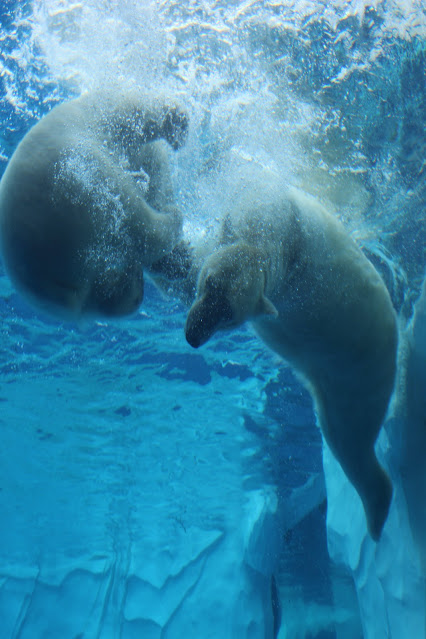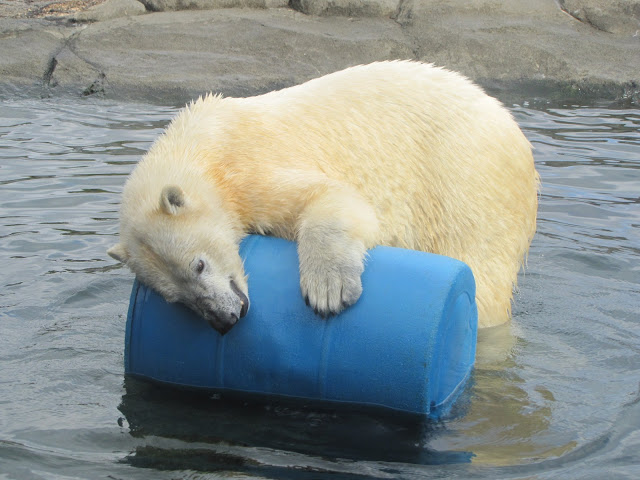 |
| Crystal and her twins December 9 - dencam photo |
Although the polar bear birthing season is not quite over, and rarely is one born in January, as far as I can see, the only cubs born and surviving in a zoo this year are Crystal and Nuka's twins in Toledo. This includes the zoos in Europe, Russia, Japan and the USA, although we get very little news from China.
There were twins born in Japan, but they only lived three days. Triplets born in Estonia did not stay, sadly. These are the only publicly announced births, besides Crystal, but sometimes zoos wait awhile before announcing, so it is possible there are cubs somewhere.
The European zoos have seen a good birthrate for their polar bears in recent years, and are now being careful not to overbreed, and thus have intentionally moved many polar bears to all-boy or all-girl groupings. With the closing of Orsa Bear Park in Sweden in October, homes are still needed for Ewa and her two year old daughter Miki, and Hope and her one year old twins.
Russia seems to be concentrating on using their valuable zoo space for orphaned or injured polar bears, and have announced no births this year. In the past, they have sent polar bear cubs to China, but this is thought to not be a good option. Very little is ever heard about these bears, once they go to China.
Canada also seems to be concentrating on their rescued orphan bears, and saw no births this year.
Japan saw two births two years ago, and another a year ago.
Zoos in the US would love to see more polar bear births, but the population is shrinking and becoming more closely related. There were no cubs born in a US zoo last year, and only the Detroit cubs the year before. The Alaska Zoo has just announced that they are taking care of a rescued yearling orphan male bear.
Crystal is an experienced mother, having already given us twins Aurora and Anana, Siku, twins Suka and Sakari, Hope, and Bo. Her daughters Aurora, the late Anana and also Suka have all produced cubs.
 |
| Crystal nursing Sakari and Suka in 2013 |
Nuka is the father of the two year old girls in Detroit, Astra and Laerke.
 |
| Nuka with Mother Suka and her daughter Astra in Detroit |
 |
| The small but mighty Laerke, only 290 pounds. |
Polar bear cubs have a high rate of mortality, estimated at 50 percent in the wild and in zoos, for they are quite immature and fragile at birth. I found this chart at Gelsenkirchen ZOOM in Germany, which shows zoo births for polar bear cubs worldwide 2001 through 2016.
These Toledo twins have made it through the riskiest time, the first two weeks, and have settled into a routine of eating and sleeping and sometimes crawling around.
 |
| A dencam photo on Dec 11 |
Twins are quite common in polar bear births, but triplets are rare, occurring maybe once a decade in a zoo. Although polar bear twins are usually about the same size, Crystal's cubs are not. The big chubby one seems to be about three times the size of the small one, but both are active and seem to be doing well. Her last set of twins, Sakari the male and Suka the female, differed in size although not to the same degree as these twins.
 |
| Suka and Sakari. |
The sad story of Swimmer
There was one other pair of polar bear cubs that were very different in size. Walker and Swimmer were born in December 2008 in Ouwehands Zoo in the Netherlands to Huggies and Victor. A dencam had been set up to film their birth and early days for Sir David Attenborough's Frozen Planet series, for it would be folly to try to film a wild mother bear. Huggies' rescue as an orphan cub had been sponsored by Kimberly Clark, thus her name, and Walker and Swimmer were named after types of their diapers.
The Ouwehands twins emerged from the den in mid-March 2009, and won the hearts of all. Less than a week later, Swimmer was dead. His mother had been teaching him to swim, and a later autopsy showed that a blood vessel in his chest had burst from the exertion, and he drowned. It is not known if this condition was related to his small size. Huggies and Walker mourned for lost little Swimmer for a long time, as the public watched. It was a very sad scene. Walker went on to become a fine healthy polar bear and now lives in Highland Wildlife Park.
This link goes to a newspaper's series of photos from the first day the twins emerged and happily played: Walker and Swimmer pics
I will never forget little Swimmer. He was here for such a short time, but touched so many.
Nuka's daughters
Nuka's daughters in Detroit, Astra and Laerke, also differ greatly in weight. When they were about a year old, Astra weighed 200 pounds, and Laerke weighed half that. But Laerke had been very fragile at birth and had to be handraised in order to survive. It is possible that medication she needed as a baby might have held back her growth. In any case, she is doing well, although will never be much bigger than she is now at about 300 pounds.
This also brings to mind another small but mighty bear, the formidable Miss Antonia of Gelsenkirchen Zoom. She was thought to be small but normal at birth, in Karlsruhe, but failed to grow like the other bears. She is a dwarf bear, weighing only about 300 pounds, but she is a feisty little thing, and is now, at age 32, is the oldest polar bear in the world (in a zoo, but wild bears don't live nearly as long as zoo bears so it is assumed she is the oldest).
 |
| Antonia of Gelsenkirchen ZOOM, at 300 pounds, the oldest polar bear in the world |
We all hope that both of Crystal's cubs grow up strong and healthy. When they come out to greet their public, I will visit as often as I can and watch these unusual twins grow and thrive. I am lucky that I live so near the only zoo with polar bear cubs in the world this year.
 |
| Crystal in September, just before denning up. She was eating her vegetables. |
 |
| Yes, Crystal, you must eat those vegetables. |
























































